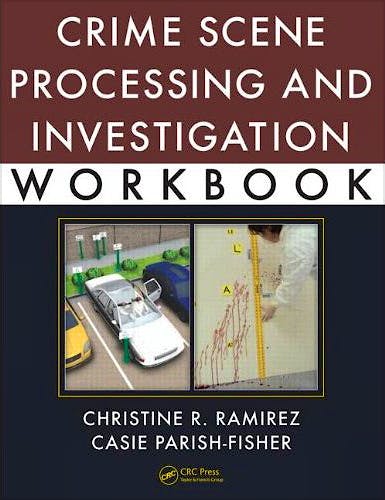

No hay productos en el carrito



Crime Scene Processing and Investigation Workbook
Ramirez, C. — Parish-Fisher, C.
1ª Edición Noviembre 2011
Inglés
Tapa blanda
226 pags
1200 gr
null x null x null cm
ISBN 9781439849705
Editorial CRC PRESS
LIBRO IMPRESO
-5%
33,26 €31,60 €IVA incluido
31,98 €30,38 €IVA no incluido
Recíbelo en un plazo de
2 - 3 semanas
Overview
The work of a crime scene investigator requires stellar organizational skills and razor-sharp attention to detail. Developing these skills is best achieved through hands-on training simulating actual case events. Crime Scene Processing and Investigation Workbook takes students from the classroom to the field and into the lab to explore a range of scenarios they will likely encounter on the job.
Exercises presented in this practical handbook include assessing the scene, crime scene photography and mapping, fingerprint evidence, documentation, impression-casting, bloodstain pattern recognition, and advanced techniques for scene processing. The book also examines the actions of the initial responding officer, highlights special scene considerations, and describes the role of crime scene analysis and reconstruction.
Designed to complement Gardner’s Practical Crime Scene Processing and Investigation, this manual uses a consistent format throughout to ensure assimilation. Each chapter begins with a list of key terms and provides learning outcomes that describe the goal of the chapter. Tasks are then broken down into specific segments, with objectives, necessary materials, and a concept overview provided to promote heightened focus on salient points in the chapter. Post-lab questions enable students to test their grasp of the material and sample worksheets are provided that can be duplicated and used in actual case scenarios. By practicing the techniques described in this manual, students will be ready when they encounter them for the first time on the job.
Features
- Complements Ross Gardner’s Practical Crime Scene Processing and Investigations textbook
- Offers a variety of activities for any budget and ranging from beginner to advanced
- Includes specific exercises incorporating the scientific method and how to effectively review scientific journal articles
- Lists the materials required for each activity along with learning objectives and post-lab questions for self-testing
- Ancillaries include a comprehensive instructor's manual and PowerPoint® slides available with qualifying course adoption
Table of contents
- Chapter 1
- CSI Effect
- Evaluation of Crime Scene Context
- Chapter 2
- Mechanical Fit
- Fingerprint Pattern Examination
- Impression Evidence (Shoe/Tire)
- Evidence Evaluation
- Biological Presumptive Test
- Glass Evidence
- Chapter 3
- Evaluation of Proper Policing Techniques
- Chapter 4
- Evaluation of Crime Scene Processing Methodology
- Chapter 5
- Search Patterns
- Evaluation of Multiple Search Pattern Techniques
- Chapter 6
- Crime Scene Photography
- Advanced Crime Scene Photography
- Chapter 7
- The Basics of Measuring
- Crime Scene Mapping Methodology
- Crime Scene Sketching
- Chapter 8
- Crime Scene Field Notes
- Crime Scene Report Writing
- Comprehensive Written Documentation Exercise
- Chapter 9
- Fingerprint Powder and Cyanoacrylate Ester Fuming Exercise
- Fingerprint Chemical Processing
- Impression Evidence Collection (shoe, tire, and fingerprints)
- Single Particle Reagent Exercise
- Fluorescent Powder Processing
- Chapter 10
- Blood Stain Directionality
- Blood Pattern Recognition
- Blood Presumptive Testing
- Area of Origin
- Chapter 11
- Buried Remains
- Chapter 12
- Event Segment Analysis
- Flow Charting
- Crime Scene Reconstruction
- Chapter 13
- The Scientific Method
- Mock Crime Scene Analysis- A Comprehensive Exercise
Author
Christine R. Ramirez is the coordinator of the Texas Forensic Science Academy within the Texas A&M University System’s Texas Engineering Extension Service in College Station, Texas. She is an active instructor of crime scene investigation, evidence processing, friction ridge development, and bloodstain pattern analysis. She has developed forensic science courses and served as a subject matter expert for forensic science training manuals. Ms. Ramirez served as the senior crime scene investigator in the crime laboratory of one of the largest sheriff’s offices in Texas. She currently holds a Master Peace Officer license from the state of Texas, with seventeen years of investigative experience. She is a Certified Senior Crime Scene Analyst by the International Association for Identification and is a court-qualified expert in bloodstain pattern analysis and latent print examination. She graduated from Sam Houston State University with a Bachelor of Science degree in Criminal Justice. Ms. Ramirez is a member of the International Association for Identification, Texas Division of the International Association for Identification, and International Association of Bloodstain Pattern Analysts.
Casie L. Parish-Fisher is currently assistant professor of forensic science in the Bachelor of Science Degree Program at St. Edward’s University, Austin, Texas. She graduated from Baylor University with a Bachelor of Science degree in forensic science. She completed her Master’s of Science degree in DNA profiling at the University of Central Lancashire, Preston, England, and is currently matriculating on her PhD in research topics relating to DNA analysis. She is coeditor of a sui generis anthology titled Pioneering Research in Forensic Science (Lewiston-Queenston-Lampeter: Edwin Mellen Press, 2009) with colleagues from St. Edward’s University, Dr. David M. Horton and instructor Michelle Y. Richter. She is a member of the International Association for Identification and the Texas Division of the International Association for Identification where she is a member of the board of directors and serves on the program committee, the host committee, and as chair of the student membership committee.
© 2025 Axón Librería S.L.
2.149.0